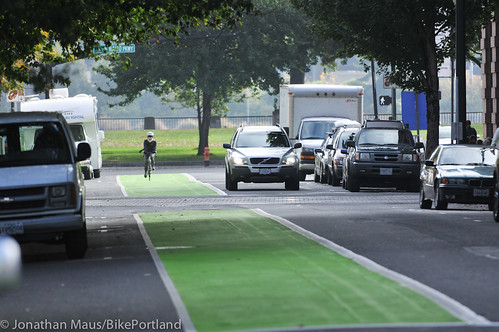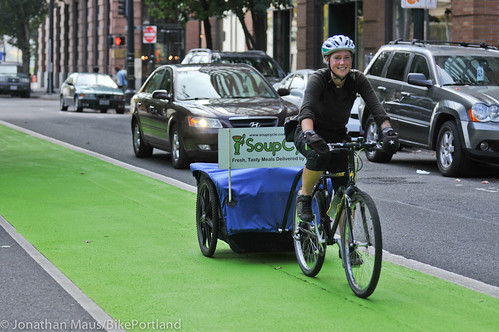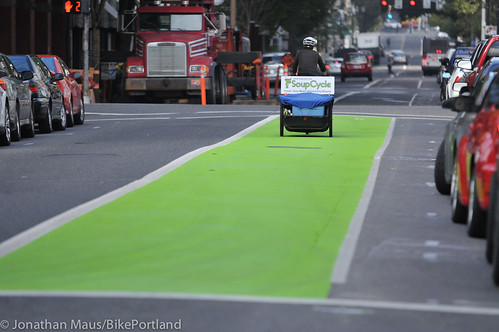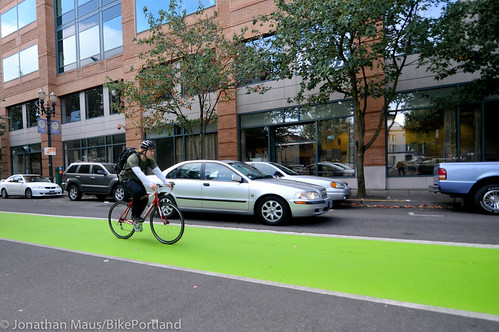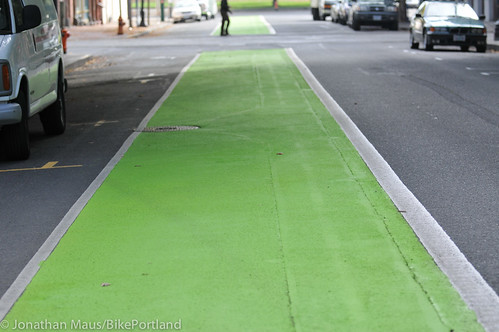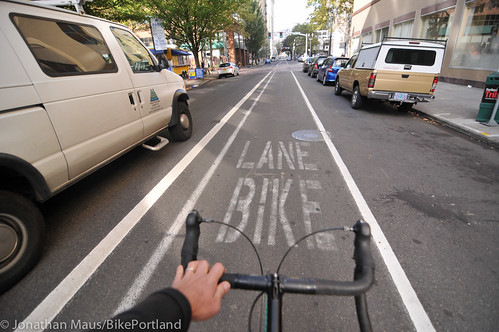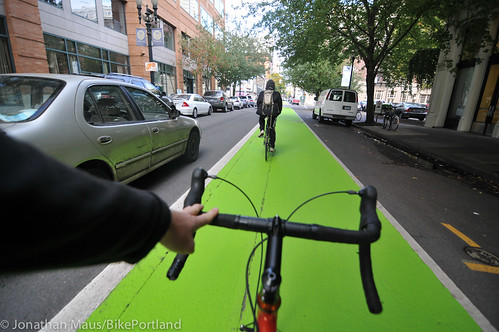As promised earlier this month, the Portland Bureau of Transportation (PBOT) has begun applying green paint to the bike lanes on SW Stark and Oak. As of this morning, crews had painted three blocks of SW Oak Street from Naito Parkway to SW 3rd.
When the buffered bike lanes on these streets were installed back in 2009, they had only a few square feet of green paint at the start of each intersection. After it became clear to PBOT that people continued to drive in the lanes, they began to consider ways to beef up the visibility. The new plan is to completely blanket the lanes with green paint in hopes that it communicates to road users that the lane is for bicycle traffic only.
Of note with this project is that PBOT is debuting a brand new type of green material. In all past applications of green colored bike boxes and lanes, PBOT used large sheets of thick thermoplastic (similar to grip tape on a skateboard) that was laid down piece-by-piece and then melted onto the pavement with a torch.
According to PBOT, the new paint is called HOTLINE® Fast Dry Latex Traffic Marking Paint with a skid-resistant agent additive known as “Sharkgrip.” They bought it from Sherwin-Williams Co. for $16,697.20 (enough for 40,000 square feet of pavement). PBOT plans to use this same paint on the NE Multnomah project.
Here’s a close-up…
PBOT Bike Coordinator Roger Geller has been part of a national effort to find the ultimate green pavement material. Geller and PBOT staff researched the market for a paint that would offer skid-resistance, provide good color stability, could be applied by in-house staff and would be affordable (their top priority was skid-resistance). They found six types of paint and put each one through a battery of tests including: a “scuff test”, where testers dug their heels into the paint; the “bicycle push test” where bikes were slid across the pavement while holding the front brake; and a “ridden bicycle skid test” where testers approached each paint sample at speed and then applied their brakes once on the material. Geller also referred to guidance from the NACTO Urban Bikeway Design Guide and from colleagues around the country who are also experimenting with green markings.
Here’s a photo of the materials PBOT tested (taken from a write-up Geller did about the process and his findings)…

The result looked great during my brief observations this morning. The material is the right color, highly visible, and it has a rough texture that isn’t slippery.
During the 10-15 minutes I watched traffic, I didn’t see any blatant misuse of the bike lane by people in cars. The look and feel is also dramatically different than before (see before/after images below). Even without any physical separation, the bright green is impossible to miss. Yet, while it’s highly visible, the ultimate test will be whether people understand that green means the lane is only for bicycling (with exceptions for parking and turning movements).
Just to give you an idea of the before/after conditions on SW Oak. Below is the current condition of the bike lane…
And here it is with the new paint…
I’ll hold off judging it’s effectiveness until PBOT has completed the installation (yes, bicycle symbols will be added). But so far, my first impressions are very positive. Add in the fact that this paint is easier and cheaper for PBOT to install, and this could be an important step in the right direction.




